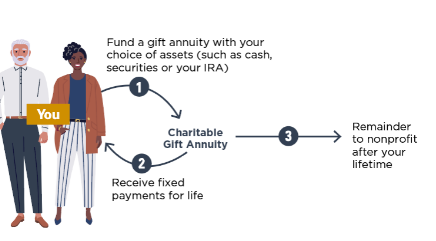Combining Generosity and Security: Understanding Charitable Gift Annuities
A charitable gift annuity (CGA) is a powerful financial tool that combines philanthropy with financial security. It allows you to support a charitable organization while receiving a steady stream of income for life. For individuals who want to give back while ensuring personal financial stability, charitable gift annuities offer a unique and mutually beneficial solution.
What is a Charitable Gift Annuity?
A charitable gift annuity is a contract between a donor and a nonprofit organization. The donor makes a significant donation to the charity, and in return, the charity agrees to pay the donor (or a designated beneficiary) fixed, regular payments for the rest of their life.
After the donor’s lifetime, the remaining funds are retained by the charity to support its mission.
How Does a Charitable Gift Annuity Work?
- The Donation
- The donor contributes a gift of cash, securities, or other assets to the charity.
- The minimum gift amount varies but often starts around $10,000.
- Annuity Payments
- The charity pays the donor (or another named recipient) a fixed income for life.
- Payments are determined based on the donor’s age at the time of the gift—older donors typically receive higher payout rates.
- Remainder Gift
- After the donor’s passing, any remaining funds go to the charity to support its programs and initiatives.
Benefits of Charitable Gift Annuities
- Guaranteed Income for Life
A CGA provides financial security by offering fixed payments, regardless of market fluctuations. - Tax Advantages
- Immediate Tax Deduction: Donors may qualify for a charitable income tax deduction at the time of the gift.
- Partially Tax-Free Payments: A portion of the annuity payments is often tax-free, as it’s considered a return of the donor’s original gift.
- Capital Gains Relief: Donors contributing appreciated assets, such as stocks, can reduce capital gains taxes.
- Supporting a Cause You Love
By establishing a CGA, you provide long-term financial support to a charity, ensuring your gift contributes to its mission for years to come. - Legacy Creation
A CGA is a meaningful way to leave a lasting legacy, reflecting your values and commitment to making a difference.
Who Should Consider a Charitable Gift Annuity?
Charitable gift annuities are ideal for:
- Individuals Seeking Financial Security: Those who want a steady income in retirement while supporting a cause.
- Philanthropically-Minded Individuals: Donors who wish to make a substantial contribution to charity.
- Older Donors: Individuals over 60 typically receive higher annuity rates, making CGAs an attractive option for seniors.
- People with Appreciated Assets: Those with stocks or property that have increased in value can reduce their tax burden while donating.
How Annuity Rates Are Determined
Annuity payment rates are influenced by:
- Age of the Donor: Older donors receive higher payout rates due to a shorter life expectancy.
- Gift Amount: The size of the donation determines the total annuity payments.
- Charity Guidelines: Many charities follow rate recommendations from the American Council on Gift Annuities (ACGA) to ensure fair payouts.
Example of a Charitable Gift Annuity
Let’s say a 70-year-old donor contributes $50,000 to a nonprofit in exchange for a CGA. Based on the current rate of 5.1% for their age:
- The donor will receive $2,550 annually for life.
- Part of this income will be tax-free for a specified period.
- The donor qualifies for a charitable tax deduction, potentially saving thousands in taxes.
- After the donor’s passing, any remaining funds will benefit the charity’s programs.
Considerations and Risks
- Irrevocable Gift
Once a CGA is established, the gift cannot be withdrawn or refunded. - Charity’s Financial Stability
Annuity payments depend on the charity’s ability to manage its financial obligations. Donors should research the organization’s stability before entering into an agreement. - Not Suitable for Short-Term Needs
If you require immediate access to your assets or greater liquidity, other charitable giving methods may be more appropriate.
How to Establish a Charitable Gift Annuity
- Choose a Charity
Select a nonprofit organization that aligns with your values and is qualified to offer CGAs. - Review Your Financial Situation
Consult a financial advisor or tax professional to ensure a CGA fits your overall financial and philanthropic goals. - Determine the Asset to Donate
Decide whether to contribute cash, securities, or other assets, and assess the tax implications of your gift. - Sign the Agreement
Work with the charity to finalize the CGA contract, specifying the donation amount and payment terms.
Conclusion
A charitable gift annuity is a powerful way to combine generosity with financial security. It provides a steady income for life, significant tax benefits, and the satisfaction of supporting a cause you care about. Whether you’re planning for retirement or looking to leave a meaningful legacy, a CGA is a mutually beneficial option worth exploring.
Take the first step by connecting with a nonprofit organization that offers CGAs and consulting with a financial professional. With a charitable gift annuity, you can give back while securing your financial future.
Also Read :







Leave a Comment